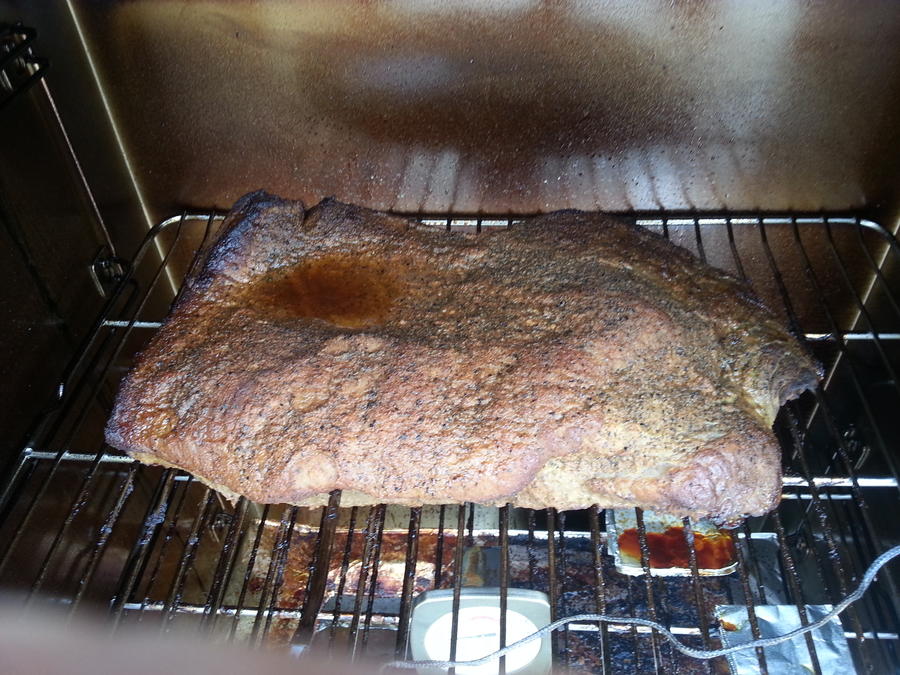This is my second attempt at smoking a brisket (ever). I got the gen2 40 MES a few months ago, and so far my attempts have been so-so. The first brisket was pulled to soon, as I over slept and my smoker turned off. I didn't do enough research and didn't know about stall times, and just figured 1.5 hours per pound and went to sleep. It was good, but not slap your momma good. LOL.
So here I am trying this again, and I finally started looking at the internal temp of the smoker and new meat probes (I threw away 4 after my attempt at a Boston butt). I realized my internal temp was off by almost 30° and my factory meat probe was also off by roughly 12°. So nonetheless, I ordered a Maverick Wireless BBQ Thermometer Set - Maverick ET732 today, but I do have instant one that got today from Wal-Mart (surprisingly dead on by the boil test) that will get me by till Tuesday when it gets delivered. I am also using a oven thermo till the Maverick comes in as well. Sorry about the back story, I will get to the heart of the post.
I trimmed this last night about 630pm, and the used a standard mustard rub and then I used my own seasoning that I have been making myself for about 6-7 years. Wrapped in foil and let it sit over night, then took it of the refrigerator an hour before I was ready to put in the MES. If your wondering, I put it in about 715 this morning, as I am no hurry as to when it is done (it was a 6.60lb brisket before trimming). Like I keep reading everywhere here, it will be done, when its done. Besides, I am still learning as this is completely new to me (smoker and the act of smoking itself).
Before I forget, I am using combination of cherry and pecan wood chips. And I am also spraying with apple juice (in a sprayer) every hour. hence the reason the puddle on top of the brisket in the second picture.
There will be pictures and updates to follow.
This the brisket at 7am this morning at letting it sit on the counter for just over a hour.
If there are any pointers, or I am forgetting anything, let me know please.
This was just after 4 hours
So here I am trying this again, and I finally started looking at the internal temp of the smoker and new meat probes (I threw away 4 after my attempt at a Boston butt). I realized my internal temp was off by almost 30° and my factory meat probe was also off by roughly 12°. So nonetheless, I ordered a Maverick Wireless BBQ Thermometer Set - Maverick ET732 today, but I do have instant one that got today from Wal-Mart (surprisingly dead on by the boil test) that will get me by till Tuesday when it gets delivered. I am also using a oven thermo till the Maverick comes in as well. Sorry about the back story, I will get to the heart of the post.
I trimmed this last night about 630pm, and the used a standard mustard rub and then I used my own seasoning that I have been making myself for about 6-7 years. Wrapped in foil and let it sit over night, then took it of the refrigerator an hour before I was ready to put in the MES. If your wondering, I put it in about 715 this morning, as I am no hurry as to when it is done (it was a 6.60lb brisket before trimming). Like I keep reading everywhere here, it will be done, when its done. Besides, I am still learning as this is completely new to me (smoker and the act of smoking itself).
Before I forget, I am using combination of cherry and pecan wood chips. And I am also spraying with apple juice (in a sprayer) every hour. hence the reason the puddle on top of the brisket in the second picture.
There will be pictures and updates to follow.
This the brisket at 7am this morning at letting it sit on the counter for just over a hour.
If there are any pointers, or I am forgetting anything, let me know please.
This was just after 4 hours








